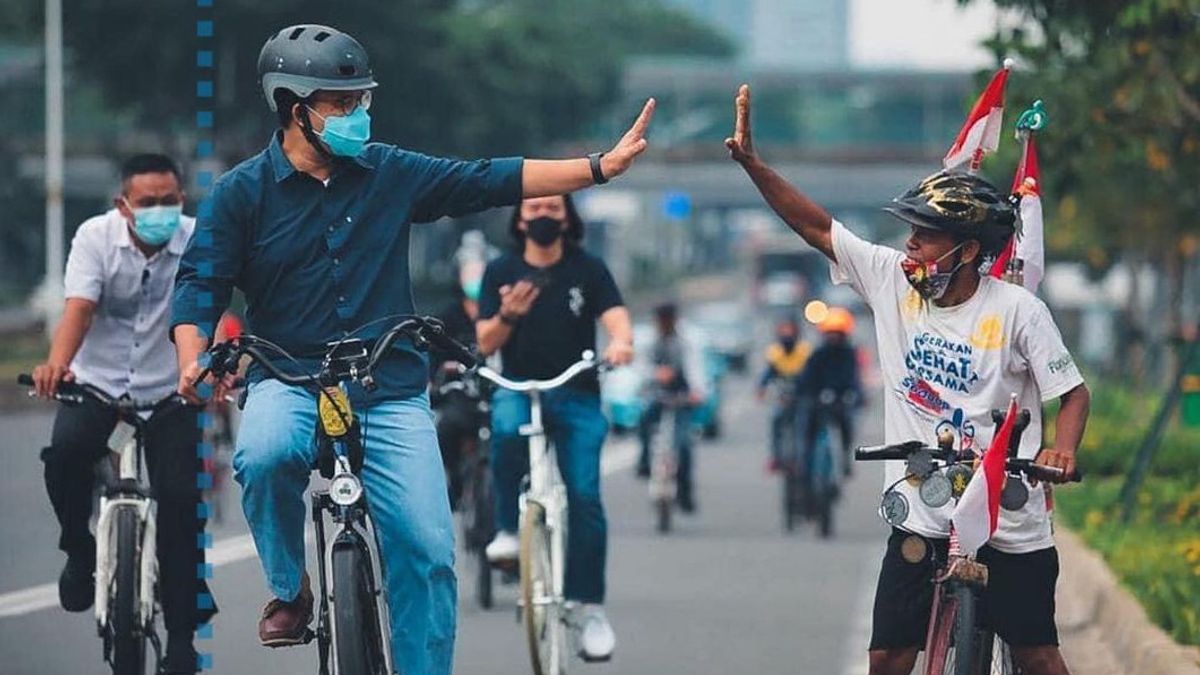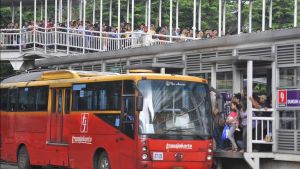JAKARTA - The corona virus may not be picky. Even with the disease it causes, COVID-19 is not indiscriminate. However, the matter of impact is different. The pandemic is clearly a question of social class. COVID-19 is more disastrous for the poor, the marginalized, and all the lower classes. As for the upper class, COVID-19 is much more "handled." Don't curse just yet. Let's learn from the positive case of COVID-19, DKI Jakarta Governor Anies Baswedan.
Early in the morning, December 1st, our cell phones were busy. Response notification. The source is from the same chat room: office editorial group. "Anies is positive," wrote a field reporter which was followed by a video of Anies' statement.
In the statement in the video sent officially by the DKI Jakarta Provincial Government, Anies explained protocol after protocol that he did in his daily life, including routine swab tests. There were several series of swab tests that were crucial before Anies tested positive. First, the test on Wednesday, November 25th. At that time Anies's test results were negative.
After that Anies received news that Deputy Governor Ahmad Riza Patria had contracted COVID-19 from his personal staff, Anies conducted an antigen swab test on November 29. The results were also negative. However, 30 November Anies again underwent a PCR swab test to confirm the antigen results the previous day. That evening, Anies received news that the results were positive.
Through the video, Anies also appealed to everyone who interacted with him in the last few days to carry out a PCR swab test or independent isolation. "For anyone who has met me, please contact the nearest puskesmas to undergo a swab test. The Health Office tracing team will record data, contact all close contacts, and all related procedures will be carried out," said Anies.
We agree that COVID-19 can affect anyone. Including Anies. For Anies, as he explained, he could run the protocol smoothly. Swab test series, even post-self follow-up protocol tested positive. For others, that is not necessarily the case.
Low class disaster
Pandemics are a class problem. Its nature can no longer be seen from just who is infected and who is not. Talking about a pandemic, we need to highlight many other factors, such as access to health, information, and even a series of other policies taken by a country, including budget management.
The impact of the pandemic on the lower classes of society is more destructive. The class shaking caused by COVID-19 has made them even more crushed, both socially and economically.
Max Weber, one of the founders of social science, has provided a strong foundation for viewing the COVID-19 pandemic from the aspects of structural imbalances related to class, status and power. He provides a class analysis framework - which is widely used as a reference today - by dividing the class into three parts: lower (lower class), middle (middle class), and upper (upper class).
As is well known, the socio-economic structure of Indonesia's population is still dominated by the lower and middle classes. According to data presented by the Indonesian Minister of Finance Sri Mulyani, Indonesia's middle class population will reach 60 million people in 2019.
Theoretically, the number of the lower class could be almost twice that of the middle class. Even according to the World Bank (2020) the proportion of the lower class in Indonesia reaches 79 percent, the middle class is 20 percent, and the upper class is only less than one percent.
The Habibie Center's Program and Research Director, Mohammad Hasan Ansori, in his writing entitled the COVID-19 Outbreak and Social Class in Indonesia explained the problem of pandemics and social class in this country more specifically. He explained that the lower class people in Indonesia are more vulnerable and at risk of being affected by the pandemic.
The reason is that the lower classes do not have better social resilience. This condition, said Hasan, can be prolonged if we refer to the post-disaster trauma period. Unfortunately, so far there is no data that describes the socio-economic class category of patients exposed to COVID-19.
In fact, in Jakarta, where the most cases of COVID-19 are, the authorities can only describe the gender and age variables of the patients. Whereas data on class questions is very important, at least for distributing aid in order to reduce the economic burden on certain classes in a pandemic situation.
[/ read_more]

In addition, the Large-Scale Social Restriction (PSBB) policy by strictly restricting the movement of people - except for essential needs such as the economy - has hit and has a massive impact on the economy of the lower classes, especially workers in the informal sector and / or daily workers. In this case, said Hasan, not leaving the house can have different meanings and consequences for each class. For the lower class, not leaving the house can mean not being able to eat at all on that day.
In line. National Islamic University (UIN) sociologist Syarif Hidayatullah, Tantan Hermansyah, said that the pandemic has caused the economic conditions of the lower class to be increasingly squeezed. The most significant contributing factor is how the pandemic causes shocks to every social class, not just the lower class.
The pandemic has caused those in the upper class to begin to decline to the middle class. Then those in the middle class, although there are still many who survive, cannot be denied that they also experience a decline in social class. So how about the lower class?
"This is what is suffering the most," Tantan told VOI, Tuesday, December 1. "The economy pie in this class is very limited, now they have to fight for opportunities with those in the upper class," added Tantan.
This is where the state comes in. The government must be able to support the lower class society through fulfilling basic needs, including giving them the same power to deal with various problems in the midst of a pandemic. Equitable access to health through swab tests which are not only affordable but also free, which is not only free but also affordable is a responsibility that must be fulfilled by the government.
[/ read_more]
Swab test costs are a problem
One of the reasons why efforts to contain the spread of COVID-19 are like chopping water is the cost that must be paid by someone to do a swab test. This problem not only hinders the handling of the pandemic, but also torments their lives.
The story of Ervina Yana, a pregnant woman in Makassar, South Sulawesi, is a picture of the state's failure to protect its citizens. It was reported by the BBC, Ervina lost the child in her womb after being unable to pay the swab test fee of IDR 2.4 million. Even though at that time he needed quick action for pregnancy surgery.
The government, as of October 5, has indeed issued a circular (SE) regarding the maximum cost limit for the PCR COVID-19 test. In the circular, the maximum cost limit for an independent PCR test is IDR 900 thousand. Still relatively high. In comparison, India. Currently, the Indian government sets the most expensive price for the swab test at IDR 468,000, as quoted by Bisnis.
The Ministry of Health, through the SE, admitted that there were problems in the price of the PCR test, especially about price uncertainty. Therefore, uniformity is needed.
"RT-PCR examinations conducted by hospitals or laboratories currently have varying rates, causing uncertainty for all parties involved in RT-PCR examination services. Based on this, the Government needs to set a standard tariff for RT-PCR examinations by considering the service components. services, components of consumables and reagents, components of administrative costs, and other components, "said the letter published months after Ervina lost its contents in June.

Unfortunately, the uniformity of Rp. 900 thousand is still not a fair solution. Public policy observer, Trubus Rahadiansyah, urged the government to eliminate the cost of testing for COVID-19. And not only free, but also evenly distributed for all. In addition to protecting the lower class society, however, testing is the spearhead for dealing with a pandemic, as the 3T formula is often socialized (tracing, testing, treatment).
"Should, (the test) be carried out massively, and because that is where we know the level of progression of COVID-19 transmission ... The tests should be completely free," Trubus told VOI.
In the central government there is a uniform tariff, in Jakarta there is an free swab test at puskesmas. Unfortunately, that is not enough because it is specifically for residents who have close contact with positive COVID-19 patients. As Trubus said, free is not enough, but we also have to open the widest possible access to swab tests to the public.
"Those who are tested because the tracing results are done for free. If there are residents who want to do the testing because they want to know for themselves, don't use tax money," Anies said in a virtual discussion last November 24, as quoted by CNNIndonesia.
Anies said residents who have never had close contact with COVID-19 patients can carry out independent testing at private hospitals. But at your own expense.
[/ read_more]
Free rates are possible
A pandemic, said Trubus, should have been completely a government affair. "Law Number 6 of 2018 clearly regulates that quarantine matters are the affairs of the central government," he said.
Not to mention, said Trubus, when referring to "Presidential Decree (Keppres) Number 11 concerning Health and Presidential Decree Number 12 concerning COVID-19 as a national disaster, it is all borne by the government," he explained.
That means it is no longer an exception to getting a free COVID-19 test. "Because with the tariffs, what happens then we are slow in handling the COVID," said Trubus.
Then, the question will appear, "is the money available?" Trubus said, money to free COVID-19 tests should exist and must exist. Especially in DKI Jakarta, which recorded the most cases of the new corona virus.
Trubus said, in the DKI Jakarta Regional Budget prepared for 2021, the budget allocated for the salaries of council members is proposed to reach Rp. 8 billion per year. That means that if the money for board members' salaries is so large, it should be available to tackle the pandemic, especially to eliminate testing.
"This means that the money is there. The person they submit, means he knows there is money there," said Trubus.
However, according to Trubus, not many people know about the budget management. "Until now, COVID-19 budget management is not transparent," he concluded. An issue that we must also highlight in the future.
[/ read_more]
The English, Chinese, Japanese, Arabic, and French versions are automatically generated by the AI. So there may still be inaccuracies in translating, please always see Indonesian as our main language. (system supported by DigitalSiber.id)









